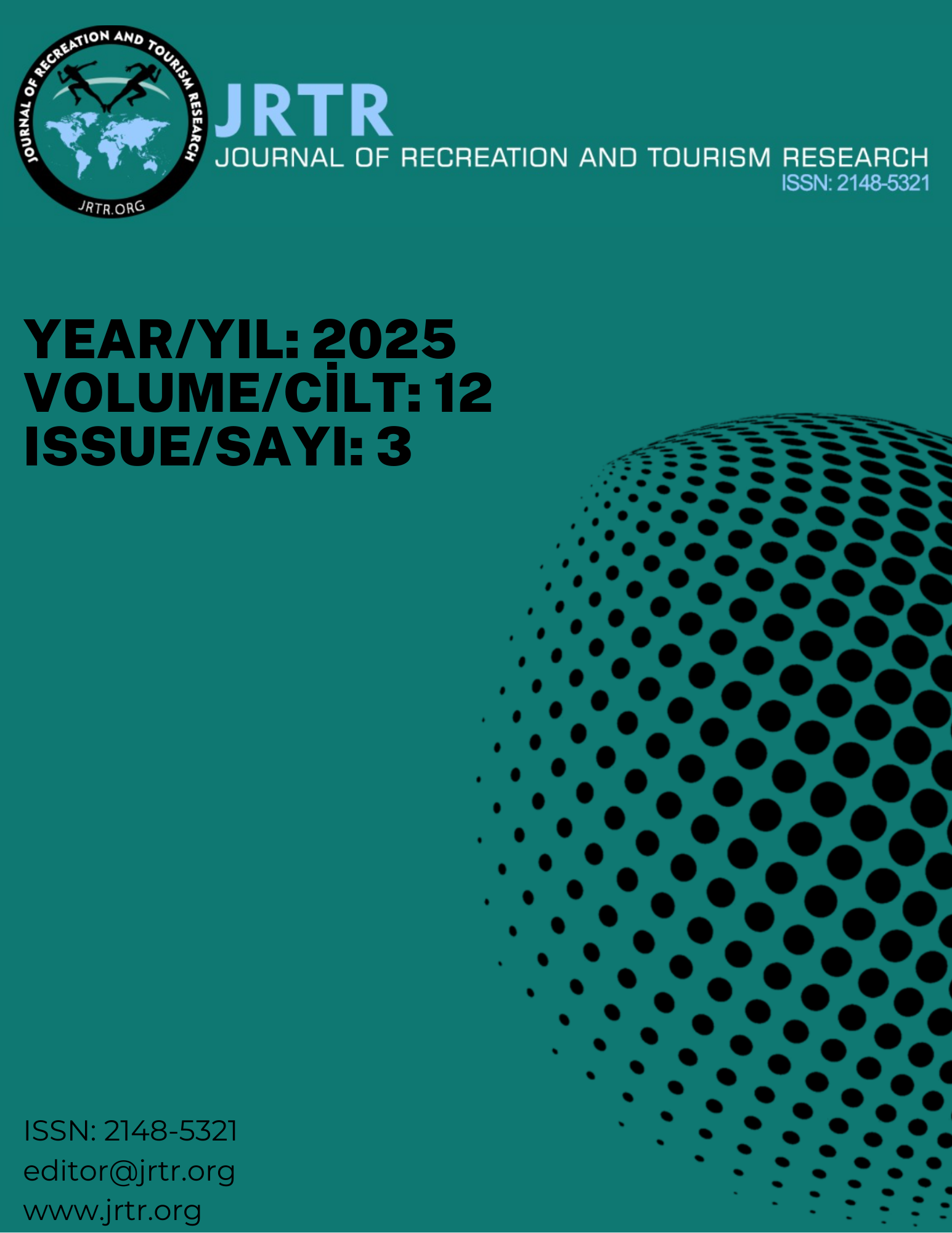A Research on Dishes with Geographıcal Indication Registration in Turkish Cuisine
DOI:
https://doi.org/10.5281/zenodo.17223253Keywords:
Geographical Indication, Turkish Cuisine, Local DelicaciesAbstract
The aim of this study is to examine the current status of dishes with geographical indication registration in Turkish cuisine and to increase the visibility of registered flavors that remain in the background. Data was obtained from the Turkish Patent and Trademark Office's "Geographical Indications Portal" and a total of 716 dishes with geographical indication were identified. These dishes were classified into 34 different food groups. The findings showed that the most registered food group was pastries, followed by meat dishes and desserts, respectively. Regional analyses revealed that the Southeastern Anatolia Region has the richest geographical indication heritage, followed by the Central Anatolia and Black Sea regions. In terms of provinces, Gaziantep ranked first with the most dishes with geographical indications, while Konya and Diyarbakır ranked second and third, respectively. It was also revealed that the number of geographical indications in the Marmara Region and some provinces was low and that the gastronomic potential could not be sufficiently evaluated in this context. In addition, in promotional activities, it is recommended that other registered dishes be included in the promotion instead of promoting destinations only with certain geographically indicated dishes.
Downloads
References
Akan, L. S. (2005). Safranbolu mutfak kültürü üzerinde bir araştırma. [Yüksek Lisans Tezi, Fen Bilimleri Enstitüsü, Ankara Üniversitesi, Ankara].
Akgöl, Y. (2012). Gastronomi turizmi ve Türkiye’yi ziyaret eden yabancı turistlerin astronomi deneyimlerinin değerlendirilmesi. [Yüksek Lisans Tezi, Gastronomi ve Mutfak Sanatları Ana Bilim Dalı, Sosyal Bilimler Enstitüsü, Mersin Üniversitesi, Mersin].
Barham, E. (2003). Translating terroir: the global challenge of French AOC labeling. Journal of Rural Studies, 19(1), 127-138.
Bérard, L. ve Marchenay, P. (2008). From Localized Products to Geographical Indications. Awareness and action. Bourgeen-Bresse, France: CNRS.
Çoşan, D. ve Seçim, Y. (2019). Bartın mutfak kültürü içerisinde tatlıların yeri ve önemi üzerine nitel bir çalışma. Karadeniz İncelemeleri Dergisi, 14(27), 279-292.
Çolakoğlu, N. K. ve Sarıışık, M. (2023). Türk mutfağında yer alan coğrafi işaret tescil belgesine sahip çorbalar üzerine bir araştırma. Kent Akademisi, 16(3), 1820-1834.
Durlu-Özkaya, F. ve Can, A. (2012). Gastronomi turizminin destinasyon pazarlamasına etkisi. Türktarım Dergisi, 206, 28-33.
Ercelep, B. ve Akdemir, N. (2022). Tescilli coğrafi işaretli gıda ürünleri: Türk tatlıları örneği. Gastroia: Journal of Gastronomy and Travel Research, 6(3), 550-563.
Ertaş, Y. ve Gezmen-Karadağ, M. (2013). Sağlıklı beslenmede Türk mutfak kültürünün yeri. Gümüşhane Üniversitesi Sağlık Bilimleri Dergisi, 2(1), 117-136.
Güzeler, N. ve Özbek, Ç. (2021). Traditional anatolian ceremonial dishes. Aydın Gastronomy, 5(2), 167-176.
Likoudis, Z., Sdrali, D., Costarelli, V. ve Apostolopoulos, C. (2016). Consumers’ intention to buy protected designation of origin and protected geographical indication foodstuffs: The case of Greece. International Journal of Consumer Studies, 40(3), 283-289.
Lucatelli, S. (2004). Appellations of origin and geographical ındıcations in oecd member countries: economic and legal implications. Organisation for Economic Co-operation and Development, 1-73.
Maviş, F. (2003). Endüstriyel Yiyecek Üretimi. Ankara: Detay Yayıncılık.
Ministry of Culture and Tourism (2020), Genel Özellikleriyle Türk Mutfak Kültürü, https://aregem.ktb.gov.tr/TR-12762/genelozellikleriyle-turk-mutfak-kulturu.html, [Erişim tarihi: 19.11.2024].
Sabur, D. G. ve Güneş, S. G. (2024) Türk mutfak kültürü ve coğrafi işaretli mantılar. A. Sökmen ve Ç. Aydın (Ed.), Sofradaki bilim ve lezzetteki sanat: Gastronomiye kapsamlı bir bakış (ss. 548-564). Ankara: Detay yayıncılık.
Sarıipek, S. ve Çevik, S. (2020). Oraların nesi meşhur: Şehir pazarlamasında coğrafi işaret tescilli ürünler. OPUS International Journal of Society Researches, 16(32), 4907-4938.
Schulp, J. A. ve Tirali, I. (2008). Studies in immigrant restaurants I: Culinary concepts of Turkish restaurants in the Netherlands. Journal of Culinary Science & Technology, 6(2-3), 119-150.
Şen, M. A. ve Ekinci, E. (2020). Türkiye’de üretilen coğrafi işaret ile tescillenmiş ekmek çeşitleri üzerine bir nitel araştırma. Journal of Eurasia Tourism Research, 1(1), 32-41.
Şengül, S. (2024). Tarihsel ve Kültürel Boyutlarıyla Türk mutfağı. Ankara: Detay Yayıncılık.
Şengül, S. Ve Türkay, O. (2022). Türkiye’nin Yöresel Mutfakları. Ankara: Detay Yayıncılık.
Toygar, K. (1981). Değişen Türk mutfağı. Türk Mutfağı Sempozyumu Bildirileri, 153-160.
Tufan, Ö. (2008). Helvahane ve Osmanlı’da helva kültürü. A. Bilgin ve Ö. Samancı (Ed.), Türk mutfağı (ss. 125–135). Ankara: Kültür ve Turizm Bakanlığı.
Türk Patent ve Marka Kurumu (2024), https://ci.turkpatent.gov.tr/, [Erişim Tarihi: 31.12.2024].
Usta, S. ve Şengül, S. (2022). Türkiye’deki coğrafi işaretli yiyecek-içecek ürünlerinin analizi. Güncel Turizm Araştırmaları Dergisi, 6(2), 604-634.
Yılmaz, S. ve Yılmaz, M. (2022). Türkiye’de coğrafi işaretli köfteler. International Congress on Food Researches, 14-16 Ekim, Sivas, Türkiye, ss. 171–182.
Yılmaz, S. ve Yılmaz, M. (2022b). Türk mutfağında pilavın yeri ve coğrafi işaretli pilav örnekleri. Y. Seçim, S. Zafer Kavacık ve C. Uslu (Ed.), Multidisipliner Yönüyle Gastronomi Alanında Güncel Çalışmalar (ss. 222-238) Konya Büyükşehir Belediyesi Kültür Yayınları.
Downloads
Published
How to Cite
Issue
Section
License
Copyright (c) 2025 Journal of Recreation and Tourism Research

This work is licensed under a Creative Commons Attribution-NonCommercial 4.0 International License.






